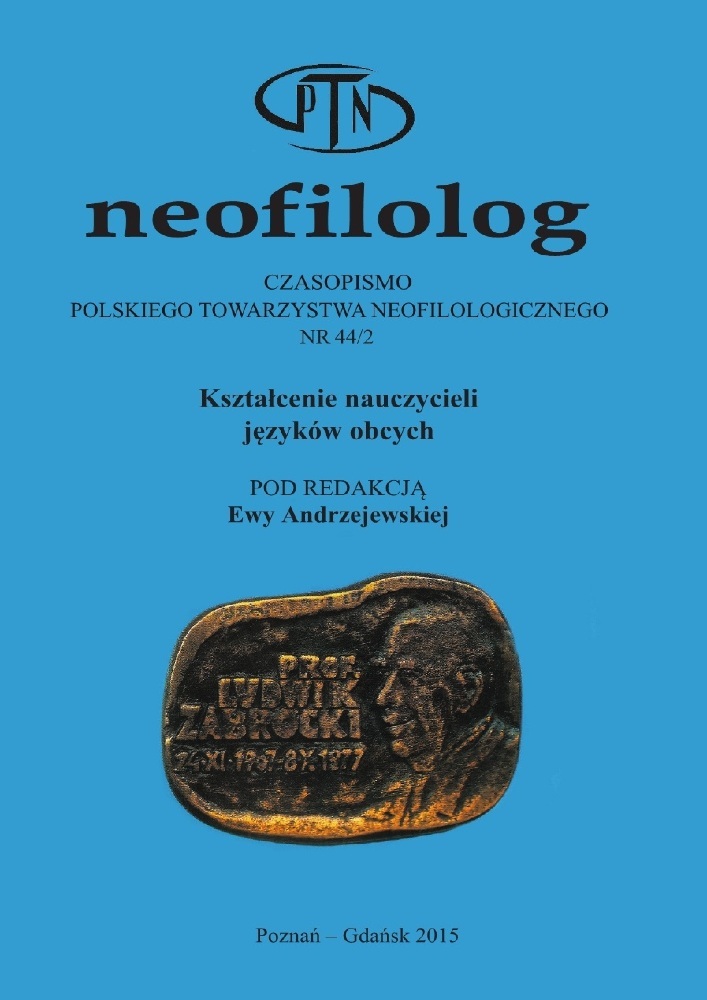Abstrakt
Teaching practice is an important stage in prospective foreign language teacher development. It is an opportunity for reflection on the teaching process as well as for (self) evaluation of one’s teaching competence. Trainees approaching their practicum should be prepared by their educational institutions for the challenges they may face in a real school context. In the article we report on two studies undertaken to obtain an insight into the practicum from the trainee perspective and from the school-based mentor perspective in the hope of identifying areas which require improvement. Descriptions of the design of the two studies and the analyses of their results are preceded by a discussion of the importance of reflection on foreign language teacher competence and the place of practicum in the development of competence.Bibliografia
Boody, R. M. 2008. „Teacher reflection as teacher change, and teacher change as moral response”. Education 128(3): 498-506.
Bush, D. 2010. „Pre-service teacher beliefs about language acquisition course as an agent for change”. Language Teaching Research 14: 318-337.
Chamcharatsri, P. B. 2010. „When the mirror reflects two faces: Critical self-reflection” (w) Observation of teaching: Bridging theory and practice through research on teaching (red. G. Park, H. P. Wideodo i A. Cirocki). München: LINCOM GmbH: 85-97
Crhová, J., Gaona, M. i Del R. 2014. „Change in beliefs on language learning of BA students in language teaching”. Jolace: Journal of Language and Cultural Education 2(2): 16-32.
Dziennik Ustaw, 2012. Rozporządzenie Ministra Nauki i Szkolnictwa Wyższego z dnia 17 stycznia 2012 r. w sprawie standardów kształcenia przygotowującego do wykonywania zawodu nauczyciela, Dz.U. 2012, poz. 131.
Łęska, K. 2009. „Wiedza merytoryczna i praktyczna nauczycieli języka angielskiego a ich przekonania dotyczące procesu nauczania” (w) Nauczyciel języków obcych dziś i jutro (red. M. Pawlak, A. Mystkowska-Wiertelak i A. Pietrzykowska). Poznań-Kalisz: Wydział Pedagogiczno-Artystyczny UAM w Kaliszu, Uniwersytet im. Adama Mickiewicza: 27-38.
Myczko, K. 2009. „Kształcenie nauczycieli języków obcych i praktyka zawodowa” (w) Nauczyciel języków obcych dziś i jutro (red. M. Pawlak, A. Mystkowska-Wiertelak i A. Pietrzykowska). Poznań-Kalisz: Wydział Pedagogiczno-Artystyczny UAM w Kaliszu, Uniwersytet im. Adama Mickiewicza: 157-166.
Newby, D., Allan, R., Fenner A.B., Jones, B., Komorowska, H., Soghikyan, K. 2007. The European Portfolio for Student Teachers of Languages. A reflection tool for language teacher education. Graz: European Center for Modern Languages.
Nunan, D., Bailey, K. 2009. Exploring second language classroom research: A comprehensive guide. Boston, MA: Heinle & Cengage Learning.
Peacock, M. 2001. „Pre-service ESL teachers’ beliefs about second language learning: A longitudinal study”. System 29(2): 177-195.
Pearson, A. T. 1994. Nauczyciel. Teoria i praktyka w kształceniu nauczycieli. Warszawa: Wydawnictwa Szkolne i Pedagogiczne.
Richards, J., Lockhardt, Ch. 1995. Reflective teaching in second language classroom. Cambridge: Cambridge University Press.
Siek-Piskozub, T. 2006. „Constructivism in language pedagogy” (w) Worlds in the Making: Constructivism and Postmodern Knowledge (red. E. Lorek-Jezińska, T. Siek-Piskozub, K. Więckowska). Toruń: Wydawnictwo Uniwersytetu Mikołaja Kopernika: 159-172.
Siek-Piskozub, T., Jankowska, A. 2013. „The role of practicum in shaping FL teacher competence” (w) Investigations in teaching and learning languages. Studies in honour of Hanna Komorowska (red. D. Gabryś-Barker, E. Piechurska-Kuciel i J. Zybert). Cham Heidelberg New York Dordrecht London: Spronger: 261-279.
Wallace, M. J. 1991. Training foreign language teachers: A reflective approach. Cambridge: Cambridge University Press.
Licencja
Prawa autorskie (c) 2019 Teresa Siek-Piskozub, Aleksandra Jankowska

Utwór dostępny jest na licencji Creative Commons Uznanie autorstwa – Bez utworów zależnych 4.0 Międzynarodowe.
Przedstawiany utwór (artykuł) upubliczniany jest na podstawie umowy z autorem i na licencji Creative Commons Attribution-NoDerivatives 4.0 International (CC BY-ND 4.0).
Użytkownicy mają obowiązek podania wraz z rozpowszechnionym utworem, informacji o autorstwie, tytule, źródle (odnośniki do oryginalnego utworu, DOI) oraz samej licencji;
- bez tworzenia utworów zależnych,
- utwór musi być zachowany w oryginalnej postaci.
Uniwersytet im. Adama Mickiewicza w Poznaniu zachowuje prawo do czasopisma jako całości (układ, forma graficzna, tytuł, projekt okładki, logo itp.).
